Tenfold Management Shares Its Vision for Vibrant Senior Living
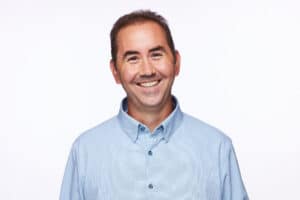
Tom Bahrman, principal of Tenfold Senior Living
I spent a few minutes with Tom Bahrman, principal of Tenfold Senior Living, the management company at Bruceville Point. He shared Tenfold’s philosophy, its unique approach to creating a rich, engaged lifestyle for residents, and some of the challenges and joys of operating Bruceville Point and its sister community, Prairie City Landing in Folsom.
(Responses have been edited for clarity and conciseness.)
You created Tenfold to manage the two communities in 2020, when Bruceville Point was preparing to open. What inspired you to create a management company?
Tom: We wanted to create intentional communities where older adults can choose how they live, where team members are seen and appreciated, and where everybody lives with joy, purpose, and connection.
Your experience in senior housing begins long before 2020.
Tom: Yes, my business partner Brigid and I have been involved in senior housing since the early 1990s. We developed different types of senior housing then, focused more on a need-based model of care. Developing Prairie City Landing in 2014, and then Bruceville Point in 2017, was an intentional pivot, a choice to refocus on creating more of a lifestyle approach to senior living. We interviewed older adults and what we discovered was the concept we abbreviate as YUSM. Older adults want to feel youthful, they want to be useful, they want to live with spontaneity, and they want to remain mobile. We adopted those goals and created five pillars to support them.
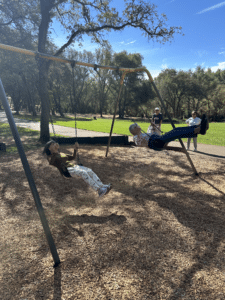
A trip to a local park demonstrates the idea of YUSM with swinging, playing disc golf, and shooting hoops.
What are the five pillars?
Tom: The five pillars support the autonomy of our residents. They are: Events and Adventures, Fitness, Culinary and Dining, Care Services, and the building design.
Fitness supports mobility, which is foundational. We have a full-time fitness director and offer more than 25 classes a week, so there is something for everyone. And we have a true gym with equipment for people who want to exercise outside of a class.
Our Events and Adventures are different than activities. They’re much more engaging. We try to do large events that you might not want to do every day, but if you want to go winetasting, or go to Tahoe, or visit a museum in San Francisco. And then we do smaller day-to-day adventures, getting people out, going to the theater, to local parks, or visiting the alpaca farm. This supports the spontaneity.
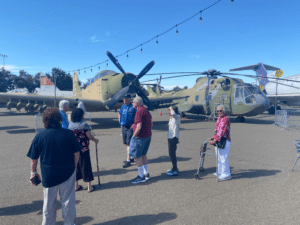
Residents of Bruceville Point enjoy an outing to the Aerospace Museum of California in North Highlands.
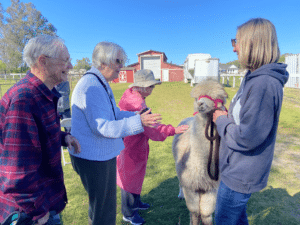
There’s nothing softer than alpaca fur! Residents enjoy a sunny trip to the farm
And our culinary program offers internationally-inspired food made to order from scratch that is beautifully presented and tastes wonderful, so your family will actually want to come and dine with you. It’s the quality you would find in your local restaurant or pub, comfortable and offering choice and variety. We have a variety of dining venues, so you can have meals in different places: the more formal dining room, the bistro, or our casual café.
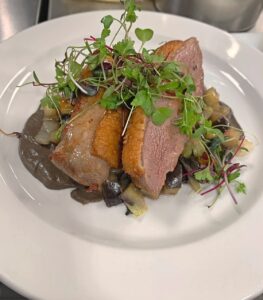
Our duck breast with black trumpet mushrooms, endive and citrus is one example of mouth-watering dishes available at our communities.
We offer assisted living as a service, not a place. Rather than a healthcare model where you have to adapt your life to the care we provide, we adapt the care we provide to your lifestyle. We bring care quietly to the privacy of your apartment on your schedule.
And then the fifth element is the building design, creating beautiful apartments with full kitchens and en-suite washers and dryers, allowing residents to maintain as much choice and autonomy as possible. They are designed with spaciousness so you can host parties in your apartment. Yes, it’s likely going to be a bit smaller than the home you lived in before, but it is big enough to feel like home. We also designed various common spaces that support our unique and vibrant programs. For example, we have a theater room, an art studio, smaller living room spaces, and the Bistro area where Events and Adventures can host on-site programs. Our fitness center is a true gym, not a weight machine or treadmill shoved in some corner.
It sounds like you are talking about ways to engage residents in the community. Why is engagement so important?
Tom: For older adults, there is a risk of inadequate nutrition because it’s hard to cook for one and not fun eating by yourself. There is also risk of social isolation at home, which can lead to cognitive decline. Our dining, fitness, and Events and Adventures programs engage our residents with team members in a fun way that significantly impacts their overall health and wellness.
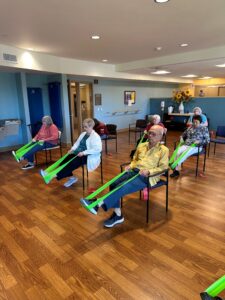
A variety of fitness classes, including one using resistance bands, engage residents in active moving and stretching.
How does Bruceville Point differ from the communities you built before Tenfold?
Tom: When people think about senior housing, the stereotype is old-school nursing homes that were mostly institutional. They were about health care. Even in the 1980s and 90s, that model had shifted to what we now consider “older-style assisted living” communities. Dining might have been batch cooking, there might have been a set menu for the day, and the quality of food may not have been great. The apartments were probably very small rooms. You had a kitchenette, not a full kitchen. You had washers and dryers down the hall, not within your apartment. Those models moved away from institutional care and offered a few amenities, but they were still primarily focused on personal care and medications as opposed to lifestyle. It’s really a shift—we can provide personalized care and assistance with daily living without sacrificing what older adults told us they wanted most—lifestyle.
Part of your mission is “building authentic community through belonging and contribution. That makes sense for team members. What does that mean for residents?
Tom: We talk about being a community of both residents and team members and we believe contribution is for everyone. Team members may be giving in a more obvious way, providing supports for our residents, and being there for connection. It works in reverse as well. We’ve had so many team members really think of some of our residents as surrogate grandparents. They’ve learned and grown from their interactions. Our residents give to our team members and really support their growth. And we also try to connect (to the community) outside of our building. We look at ways we can give back, with connections to local schools and different service projects.
Another part of your mission says, “providing support that enables autonomy in all its dimensions.” What does that look like?
Tom: Autonomy is about choice. And choice for our residents is really about having lots of options available. So, when it comes to dining, we don’t have a prescribed menu of the day, but we have lots of choices on menus. You can have breakfast at any time of the day. We have weekly specials that rotate every other week and other chef-specials to offer as much choice as possible. We think about our Events and Adventures calendar and we’ve had residents complain that the calendar is so full, it’s overwhelming. They ask, “How am I supposed to do all of this in one day?” And the answer is, you’re not! The idea with the calendar—and the fitness calendar, too—is to give residents choice throughout the day, so they can choose how they spend their time.
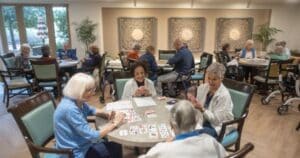
Card games are one of many fun ways to engage socially and support cognitive health.
What is the greatest challenge for Tenfold and the senior living industry?
Tom: We have a wave of aging baby boomers, lots of people who are going to be looking for supportive options. What do those options look like? What is going to serve people best? How can we create intentional communities where residents create and feel a sense of belonging? And how do we better educate everyone about senior living? We have so many residents who visit our communities and their immediate reaction is, “Wow! I want to live here. If only I knew this existed earlier.” How do we make sure people know what their options are?
And what’s your greatest joy or success?
Tom: I think it’s just walking into the communities and feeling that sense of engagement and joy that happens on any given day.
For more information about the lifestyle at Bruceville Point download our Guide below. Or schedule a tour of our community and see for yourself!
For more information about the engaging opportunities that await at Bruceville Point, download our Signature Programs Guide.
